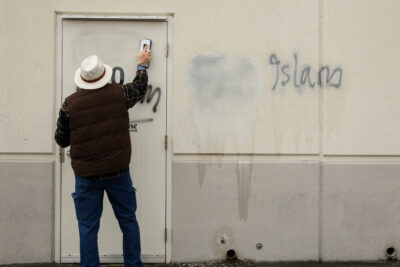Last Wednesday, July 19, was something of a busy news day. There was word North Korea was making preparations for yet another provocative missile test. The Supreme Court, in its latest ruling in the controversial travel ban case, said that people from the six largely Muslim countries covered by the immigration enforcement action could enter the U.S. if they had a grandparent here, refusing to overturn a ruling that grandparents qualified as “bona fide relatives.” And then, late in the day, President Donald Trump gave a remarkable interview to The New York Times, one that, among other things, laid into Attorney General Jeff Sessions.
The day also produced its share of what, sadly, has come to qualify as routine news: A Muslim organization in Sacramento, California, received a package in the mail that included a Koran in a tub of lard; police in Boise, Idaho, identified a teenage boy as the person likely responsible for scratching racist words on a car; in Lansing, Michigan, police launched a search for a suspect in the case of an assault against a Hispanic man. The victim had been found with a note indicating his attacker had been motivated by racial animus.
The specter of hate incidents and crimes — some of them fueled by the nastiness of the 2016 presidential campaign — felt white hot months ago. The issue remained high-profile as several horrific murders — a South Asian immigrant slain in Kansas City, a homeless black man butchered near Times Square in New York — generated outrage and national news coverage.
Documenting Hate, an effort by a coalition of news organizations, has sought to sustain a focus on incidents and crimes of racial or religious or sexual prejudice even as the temperature around the issue rises or falls. One of the truths the effort has laid bare is that such crimes are so commonplace that they can seem an almost ordinary part of the fabric of life in America.
Scattered among the news items on that single July day — captured in local write-ups and wire-service briefs — was the attempted murder of a black employee at an auto parts store in Desert Hot Springs, California, an attack during which the shooter repeated racial epithets; the menacing of a mosque in Georgia, where repeated telephone threats warned that “white people are going to kill you”; an Indian-American Ph.D. candidate in California had her car’s windshield shattered by a rock as she drove to work, glass from the window embedding in her skin and hair. “Go back to your own country,” the assailant had screamed.
“I was shocked,” Simranjit Grewal told the India West newspaper. “Another human being was trying to attack me, to hurt me.”
Earlier this year, ProPublica reported on studies done in Great Britain on hate crimes in the aftermath of the Brexit vote. Immigrants in the country faced violence, having been demonized as a threat during the polarizing and ultimately successful effort to withdraw from the European Union. One of the researchers’ findings was that the hate incidents very often did not involve fringe, ultra-nationalist and neo-Nazi groups. Instead, they were perpetrated by, as one researcher put it, “ordinary people.”
The accounts marshaled by the Documenting Hate coalition suggest the same is true in the U.S. Amid the hundreds upon hundreds of news reports of crimes and insults and threats we’ve collected, there’s an everyman quality to the accused. While the black man killed in New York was allegedly slain by a consumer of white supremacy propaganda, the immigrant shot to death in Kansas City was allegedly killed by an unremarkable suspect, a man who had worked menial jobs across his life and, according to some associates, been in a spiral of drinking and depression for months.
The kinds of suspects implicated in the events of July 19 — a teen, a somewhat bumbling young man who managed to shoot himself in the course of trying to kill an auto parts worker — turn up on other days, in other crime reports. Two college students in Berkeley, California, were charged on July 18 with spray-painting racist graffiti. A man in Oregon was arrested after swearing at and harassing a Muslim women over a 20-block span, pretending to shoot a gun and screaming at her to leave the country and remove her headdress. The man, in tears, later said his “stupidity” had got the best of him.
The news reports collected as part of the Documenting Hate project include more than just crimes. The project also tracks news accounts dealing with reports on things such as hate crime statistics and calls for new hate crimes legislation. This month, for instance, there was the formal release of a Center on Islamic-American Relations report on anti-Muslim crimes, one that showed a huge spike over the last six months, a 91 percent rise in reported incidents over the same period last year.
Also included, though, are reports of steps being taken to combat the crimes and limit their incidence and damage — committees formed, outreach initiated. This month in Montgomery, Alabama, several organizations joined to run what they called “bystander intervention training,” meant to encourage people to act when witnessing the harassment of people because of their race or religion. In Anne Arundel, Maryland, there was a protest on the courthouse steps organized in part by the NAACP to highlight a recent case of a noose being hung in a local middle school.
And in Washington, D.C., there was a conference on hate crimes run by the Department of Justice overseen by Jeff Sessions. Should the news of July 19 — Trump’s first salvo in what seems to many to be a bid to drive Sessions from office — result in a new attorney general, one of Sessions’ final acts will have been an impassioned promise to fight hate crimes.
Filed under:



